List of Brown University buildings
The following is a list of buildings at Brown University. Six buildings are listed with the United States Department of the Interior's National Register of Historic Places: University Hall (1770), Nightingale–Brown House (1792), Gardner House (1806), Hoppin House (1855), Corliss–Brackett House (1887), and the Ladd Observatory (1891).[1]
Academic Facilities
| Building | Image | Architect | Built | Location | Notes | Ref |
|---|---|---|---|---|---|---|
| 195 Angell Street |  |
1902 | Also known as the Providence Telephone Company Building, 195 Angell Street is occupied by the Department of Language Studies | |||
| Alumnae Hall | Andrews, Jones, Biscoe and Whitmore | 1927 | 194 Meeting St. | Built of brick with limestone trim, was designed to accommodate the social and religious activities of the Women's College. Its main entrance is a balustraded stone terrace on the campus leading to an auditorium on the main floor. When the building was opened a large organ was installed, the gift of Mrs. C. Prescott Knight and Mrs. Webster Knight in memory of their sister-in-law, Edith Knight. | ||
| Applied Math Building |  |
Architecture Research Office | 2015 | 170 Hope St. | Provides office space for applied mathematics faculty, graduate students, postdoctoral researchers, and visitors, as well as meeting and seminar rooms. | [2] |
| Arnold Laboratory |  |
Clarke & Howe | 1915 | 91 Waterman St. | Built with a donation from Dr. Oliver H. Arnold (class of 1865), Arnold Laboratory was designed as lab space for the biological sciences. Currently, the building houses many of the administrative offices of the Division of Biology and Medicine. | [3] |
| Barus and Holley Building |  |
Sherwood, Mills and Smith | 1963–1965 | 184 Hope St. | Named for faculty member and physicist Carl Barus and engineer Alexander Lyman Holley (class of 1853), Barus and Holley is home to the University's Physics Department and School of Engineering. At opening, the seven story building contained approximately 130 offices and over 80 labs. The later addition of Giancarlo Labs to the engineering complex added more laboratory and research space. | [4] |
| Barus Hall |  |
Angell and Swift | 1885 | 340 Brook St. | Built as the carriage house of the Henry and Elizabeth Pearce Estate. The address is also listed as 21 Manning St. | [5] |
| 88 Benevolent Street |  |
1867 | Location of the studios and offices for WBRU | |||
| Blistein House |  |
1867 | 57
Waterman St. |
Named for Elmer Blistein, Professor of Shakespeare; first Jew to graduate from Brown and first to teach there. | ||
| 333 Brook Street |  |
1900 | ||||
| 341 Brook Street |  |
1895 | ||||
| 68½ Brown Street |  |
2001 | ||||
| 70 Brown Street | 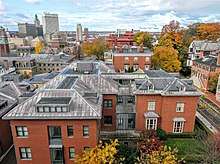 |
LLB (2001) | 1850,
2001 |
A single building integrated with the historic Samuel B. Wheaton House at 107 Angell Street houses the Brown English department | [6] | |
| Churchill House |  |
Thornton and Thornton | 1907 | 155 Angell St. | The Churchill House was originally built for the Rhode Island Women’s Club. The building was acquired by the university in 1970 and currently houses the Africana Studies Department and the Rites and Reason Theatre | |
| Dyer House |  |
John Holden Greene | 1822 | 150 Power St. | ||
| Edward W. Kassar House |  |
1884 | 151 Thayer St. | Originally built for Nancy Bishop, the University acquired the house in 1977 and named the building in honor of Edward W. Kassar. Gould Laboratory, a 1982 addition, was integrated with Kassar in 1993 to form a unified building for the Mathematics Department designed by William Kite Architects. | [7] | |
| Engineering Research Center | 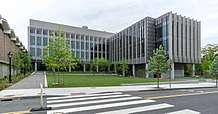 |
KieranTimberlake | 2018 | 345 Brook St. | This three-story facility features a 4,000-square-foot clean room for nanotechnology and electronics research. It has 20 lab modules which support large, collaborative research groups. | [8][9] |
| Feinstein House |  |
1917 | 130 Hope St. | |||
| Frederick Lippitt and Mary Ann Lippitt House |  |
1865 | 96 Waterman St. | |||
| Friedman Hall |  |
Gould and Angell | 1891 | 90 George St. | Originally built as "Wilson Hall," the building was extensively renovated in 2017–2018 and re-dedicated as Friedman Hall. | [10][11] |
| GeoChemistry Building | Davis, Brody and Associates and Russo and Sonder | 1982 | 167 Thayer St. | Home to the Department of Chemistry and Department of Earth, Environmental, and Planetary Sciences | ||
| 155 George Street |  |
1930 | ||||
| 180 George Street | 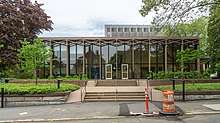 |
Philip Johnson | 1961 | The Computing Laboratory was built to house an IBM7070 computer. The building was reassigned for the use of the Applied Mathematics Division with the opening of the Center for Information Technology in 1988. | [12] | |
| 182 George Street |  |
Angell and Swift | 1885 | The Henry and Elizabeth Pearce Estate. Designed by Providence architects Angell and Swift in the Romanesque Revival style, after Henry Hobson Richardson. Brown purchased the main house in 1952. | [13] | |
| Gerard House |  |
Alpheus C. Morse (renovated) | 1838, 1867 | 54 College St. | Originally named the Whipple-Slater House, the Samuel N. Gerard House houses the department of East Asian Studies | [14] |
| Giancarlo Laboratories | .jpg) |
Payette Associates | 2001 | The Giancarlo Laboratories bears the name Charles Giancarlo (class of 1979) of Cisco Systems, Inc.. The laboratory provides the main entrance into the engineering buildings and adjoins the Barus and Holley Building and Prince Engineering Laboratory. Contained inside are state of the art labs, including the main engineering student computing facility. | [15][16] | |
| Giddings House |  |
1908 | 128 Hope St. | |||
| Gould Laboratory (annex to Kassar House) |  |
William Kite Architects | 1982 | Built as an addition to Kassar House to house the Computer Sciences Department, it was integrated with Kassar in 1993 to form a unified building for the Mathematics | [7] | |
| Granoff Center for the Creative Arts |  |
Diller Scofidio + Renfro | 2011 | 154 Angell St. | A 38,815 square-foot, three-story, interdisciplinary arts center | [17] |
| Grant Recital Hall |  |
Brian Healy Architects (renovation) | 1845, 2013 | 105 Benevolent St. | The Grant Recital Hall and its neighboring buildings were as sables and service buildings for the since-demolished Sprague-Hidden house | [5] |
| Hirschfeld House | 1900 | 163 George St. | Named for Elie and Sarah Hirschfeld, the Hirschfeld House is home to the university's Judaic Studies department | |||
| 190 Hope Street |  |
1865 | ||||
| Horace Mann House |  |
Richard Upjohn | 1854 | 47 George St. | Built for Seth Adams, Jr. in 1854, this brick Italianate double house (or duplex) building at 47-49 (formerly 24-26) George Street was designed by Richard Upjohn, first president of the American Institute of Architects. Built as an investment property, the building initially served as luxury rental apartments. Purchased by Brown University, it was renovated in 1838–1839 as a residence hall for students, first named Magee House and then renamed Horace Mann House in 1940. It has since housed the English Department and now the Brown Graduate School and the Office of the Vice President for Research. | [18][19] |
| Jerimoth Hill property | N/A | N/A | In 1953, Walter Raymond Turner (class of 1911) donated a 5-acre (20,000 m2) plot of land (as well as an easement to access the land from Route 101) atop Jerimoth Hill to the University. At 812 feet (247 m) above sea level, a rock outcropping on the Jerimoth Hill property is the highest natural point in the state of Rhode Island. The property is used by the Physics Department for astronomy courses and is largely undeveloped, containing only small sheds that house astronomy equipment. | [20][21] | ||
| Lincoln Field Building |  |
Clarke & Howe | 1903 | 180 Thayer St. | ||
| List Art Center | 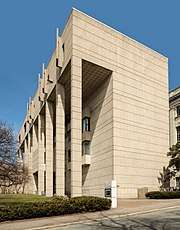 |
Philip Johnson | 1971 | 64 College St. | [22] | |
| Lyman Hall | 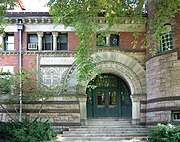 |
Stone, Carpenter & Willson | 1891 | 83 Waterman St. | Originally built as Lyman Gymnasium, Lyman Hall functioned as an athletic facility until 1946 when all sports activities were moved to Marvel Gymnasium. | |
| MacFarlane House |  |
1845 | 48 College St. | Originally known as the William J. King House, the building is currently known as the MacFarlane House and used as the main office of the school's Classics Department. | [23][14] | |
| W. Duncan MacMillan Hall |  |
Koetter, Kim & Associates | 1998 | 167 Thayer St. | The building was named for Whitney Duncan MacMillan, the principal benefactor. It houses facilities for chemistry, geology and environmental sciences research and instruction. | [24][25] |
| Manning Hall |  |
Russell Warren, William Tallman, | 1834 | 21 Prospect St. | Houses the Haffenreffer Museum of Anthropology's exhibitions and Manning Chapel. | |
| 37 Manning Street |  |
Hoppin, Read & Hoppin | 1897 | |||
| Marston Hall |  |
William W. Bosworth | 1926 | 346 Brook St. | ||
| Maxcy Hall |  |
Hoppin, Read & Hoppin | 1895 | 108 George St. | ||
| Metcalf Research Laboratory |  |
Day & Klauder | 1938 | 190 Thayer St. | ||
| Morrison-Gerard Studio |  |
1845 | 151 Hope St. | |||
| Nelson Center for Enterpreneurship |  |
ZDS Architects (Providence) | 2019 | 249 Thayer Street | [26][27] | |
| Nicholson House |  |
Stone and Carpenter | 1878–1879 | 71 George St. | Originally built for Francis W. Goddard, Nicholson House is named in honor of Mr. and Mrs. Samuel C. Nicholson, president of the Nicholson File Company and former owner of the house. Later, Nicholson house was home to University Communications. In 2017, the department of American Studies moved into the building. 71 George Street. | [28][29] |
| Norwood House | 1862 | 82 Waterman St. | Previously known as the Benjamin Stevens House, the Norwood House is used by Brown's American Civilization Program | |||
| Partridge Hall | 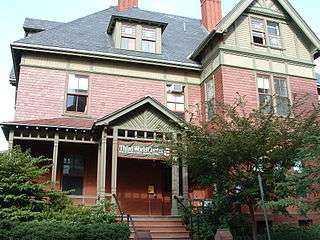 |
Alpheus C. Morse | 1894 | 68 Brown St. | Currently houses the Brown Center for Students of Color (BCSC), which was formerly known as the Third World Center. | [30] |
| Peter Green House |  |
Lerner Ladds Bartels (2007),
Kite Architects (2019) |
1868, 2007,
2019 |
79 Brown St. (formerly 142 Angell St) | Purchased by Brown in 1966 as the "Lippit-Guild House," the building was renovated in 1999 using funds donated by alumnus Peter Green. In 2007 the building was moved from its former location on 142 Angell St. to 79 Brown Street and in 2019 the building was connected to the adjacent Sharpe House. | [31] |
| Prospect House |  |
1875 | 36 Prospect St. | |||
| Prince Engineering Laboratory |  |
Sherwood, Mills and Smith | 1962 | 355 Brook St. | Part of the engineering complex, Prince Engineering Laboratory is named for Frank John Prince (director of the Universal Match Corporation of St. Louis) and is home to research in structure and materials, thermodynamics, and fluid mechanics. | [32] |
| Rhode Island Hall | 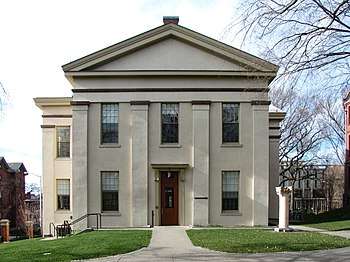 |
Tallman & Bucklin | 1840,
2009 |
60 George St. | Rhode Island Hall, so named because the majority of the funds for erecting the building came from Rhode Island residents, was originally built to house classrooms and laboratory space for the Departments of Natural Philosophy, Chemistry, Mineralogy, Geology, and Natural History. The building was renovated in 2009 and currently houses the Joukowsky Institute for Archaeology and the Ancient World | [33][34] |
| 222 Richmond Street | Frank S. Perry, Ellenzweig (renovation) | 1928 | Converted to Medical Education building for Alpert Medical School, opened in 2011. | [35] | ||
| Robinson Hall | William Walker, Thomas Gould | 1878 | 64 Waterman St. | Originally built as a library. That use ended when the John Hay Library was built. Currently houses the Economics Department. | ||
| Rochambeau House |  |
Parker, Thomas & Rice | 1929 | 84 Prospect St. | ||
| Salomon Center |  |
Alpheus C. Morse | 1862 | 79 Waterman St. | The largest lecture hall at Brown, located centrally on campus. | |
| Sayles Hall | 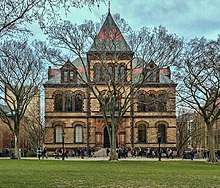 |
Alpheus C. Morse | 1881 | 81 Waterman St. | Romanesque; memorial to William Clark Sayles | |
| Sharpe House | Alpheus Morse (1872), Kite Architects (2019) | 1872, 2019 | 79 Brown St.
(formerly 130 Angell St.) |
Built for Lucien Sharpe in 1872, Brown acquired half of the building—then a duplex—in 1921. At the time, the building was used to house women attending Pembroke College. In 2018 and 2019 the building was moved and connected to the Peter Green House. | [36] | |
| 70 Ship Street |  |
Monks & Johnson | 1912 | Originally known as the Doran Speidel Building. Home to the Laboratories for Molecular Medicine. | ||
| Shirley Miller House |  |
Clarke & Howe | 1915 | 59 George St. | Originally known as the Irene M. Butler House | |
| Sidney E. Frank Hall for Life Sciences | 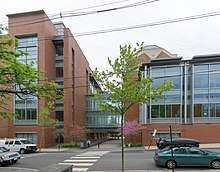 |
The Ballinger Company | 2006 | 185 Meeting St. | A five-story, 169,000-square-foot glass and brick structure devoted to the study of human biology. It is named for liquor magnate Sidney Frank, Brown Class of 1942, and the university's largest donor up to that time. | [37] |
| Smith-Buonanno Hall | 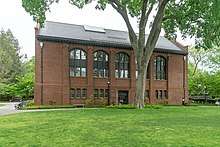 |
Stone, Carpenter & Willson | 1907 | 95 Cushing St. | Built as the women's gymnasium and originally known as Sayles Gym. Extensively renovated in 2000 by KITE Architects. | [38][39] |
| 121 South Main Street | 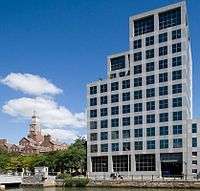 |
Edward Larrabee Barnes | 1984 | Purchased in 2005, 121 South Main Street is an 11-story building located along the Providence River in Providence's central business district. Originally Built for the Old Stone Corporation, the building since 2013 has been home to the School of Public Health. | [40] | |
| Steinert Hall |  |
1966 | 148 Power St. | |||
| Stephen Robert Hall |  |
Toshiko Mori | 2018 | 280 Brook St. | Part of the Watson Institute for International and Public Affairs. | [41] |
| T.F. Green Hall |  |
1959 | 7 Young Orchard St. | |||
| 135 Thayer Street |  |
1928 | ||||
| Thomas Whitaker house |  |
John Holden Greene | 1821 | 67 George St. | ||
| Walter Hall |  |
1857 | 80 Waterman St. | Originally known as the John F. Chaplin House | [5] | |
| 70 Waterman Street |  |
1859, 1980 | Francis E. Cross House | [5] | ||
| 85 Waterman Street (formerly known as Hunter Laboratory) |  |
Perry, Shaw, Hepburn and Dean, Toshiko Mori | 1958, 2014 | Hunter Laboratory went through major renovations in 2014 by Toshiko Mori Architects, which focused on making the building more environmentally friendly. This included LEED gold certification due to revamping the temperature control systems, adding a greywater system, and adding a greenhouse to the roof to replace the Plant Environmental Center, which was converted into a green. It now houses the Institute at Brown for Environment and Society. | [42] | |
| 131 Waterman Street |  |
1852 | Built as an Italianate residence and known as the Levi Salisbury House | |||
| 133 Waterman Street |  |
1885 | ||||
| 137 Waterman Street |  |
1910 | ||||
| Watson Center of Information Technology |  |
Cambridge Seven Associates | 1988 | 115 Waterman St. | ||
| Watson Institute for International and Public Affairs |  |
Rafael Viñoly | 2001 | 111 Thayer St. | ||
| Wilbour Hall | 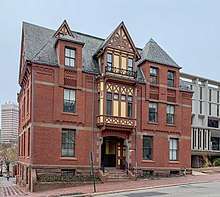 |
Stone, Carpenter & Willson | 1888 | 2 Prospect St. | Named for Charles Edwin Wilbour |
Administrative Buildings
| Building | Image | Architect | Built | Location | Notes | Ref |
|---|---|---|---|---|---|---|
| 5 Benevolent Street |  |
1844 | Originally known as the Henry B. Anthony House, 5 Benevolent Street is home to the Office of the Chancellor, a position currently held by Thomas J. Tisch (class of 1976). | [43] | ||
| 20 Benevolent Street |  |
1820 | Also known as the Jonathan Pike House, 20 Benevolent is home to the Office of Student Life. | [44] | ||
| 26 Benevolent Street | 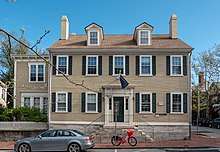 |
1823 | 26 Benevolent, also known as the Seth Adams House, is the current home of the Sarah Doyle Women's Center. | [45][46] | ||
| Benoni Cooke House |  |
John Holden Greene | 1828 | 110 South Main St. | Originally built for Benoni Cooke, Brown University acquired the house in 1995. It now houses the University's Office of Internal Audit and the Office of the Vice President & General Counsel. | [47][48][49] |
| 382 Brook Street (leased) |
382 Brook Street is home to the administrative offices of the Center for Computation and Visualization (CCV). The CCV's facilities are located at 180 George Street. | [44] | ||||
| Brown Office Building | Kent, Cruise & Partners | 1969 | Home to the Brown University Bookstore, the Brown Office Building also contains the Office of Environmental Health and Safety, Financial Services, Human Resources, and Graphic Services. | [50][51] | ||
| Corliss-Brackett House | _side.jpg) |
George Henry Corliss | 1875–1882 | 45 Prospect St. | Corliss-Bracket House was built by George Henry Corliss, inventor of the Corliss Steam Engine and later acquired by Charles Brackett, a motion picture writer, who donated the house to the University. The house has been listed with the National Register of Historic Places since 1970. Since 1973, the house has served as the Admission Office for the University. | [52][53] |
| 3 Davol Square (leased) |
Located in the Jewelry District, 3 Davol Square is home to the administrative systems groups of Computing and Information Services. The Help Desk, Service & Repair and computer operations are located in the Watson Center of Information Technology. | [54] | ||||
| 110 Elm Street (leased) |
1848 | Originally built by the Phenix Iron Foundry and once on the Providence Preservation Society's "Most Endangered Properties List", Brown University has since restored 110 Elm Street, where the Development Office is now located. | [55][56] | |||
| 8 Fones Alley | 1900 | 8 Fones Alley is home to the Financial Aid Office. | [57] | |||
| 25 George Street | 1913 | 25 George Street is home to the Swearer Center for Public Service, named in honor of Howard Robert Swearer, which opened in 1986 to provide support programs and resources to allow students to integrate public service into their education. | [44][58] | |||
| Grad Center E |  |
Shepley, Bulfinch, Richardson & Abbott | 1968 | 42 Charlesfield St. | A four-story building surrounded by the four Grad Center residence halls, Grad Center E is home to the Office of Summer & Continuing Studies, contains an athletic and recreational center named the Bear's Lair, and also is home to the Brown University Faculty and Graduate School Club (better known as the Graduate Center Bar). | [59] |
| Hemisphere Building |  |
1989 | 167 Angell Street | Home to Brown's CareerLAB | ||
| Hoppin House | 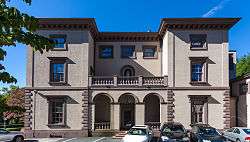 |
Alpheus C. Morse | ~1855 (variously dated) |
383 Benefit St. | Hoppin House, named for Thomas P. Hoppin, is home to the Annenberg Institute for School Reform. Founded by the Annenberg Foundation, the Annenberg Institute aims to help urban communities, schools and districts build smart school systems that provide both excellent education and equitable opportunities for every student. The house has been listed with the National Register of Historic Places since 1973. | [53][60][61] |
| Maddock Alumni Center |  |
Stone and Carpenter (~1882 addition) | ~1830 | 38 Brown St. | Maddock Alumni Center is located in the former home of Chancellor William Goddard (class of 1846). Goddard's daughter deeded the house to the University in 1940, and in 1974, the center was named in honor of Paul L. Maddock (class of 1933), the principal donor in its restoration. The building is currently occupied by the Alumni Relations. | [62][63] |
| Page-Robinson Hall |  |
Robinson, Green & Beretta, LLB | 1962 | 69 Brown St. | Originally built as the J. Walter Wilson Laboratory, as the Biology department had outgrown the Arnold Lab. The Sol Koffler wing was added in 1983.[64] In 2008 the building was renovated by LLB architects to house student-oriented administrative services and classrooms.[65] Renamed after alumni Inman E. Page and Ethel Tremaine Robinson in 2018. | [66] |
| South Street Landing |  |
Jenks & Ballou | 1912, 1952, 2017 | 350 Eddy St. | This former power station at 360 Eddy Street in the Jewelry District was completely renovated in 2017 into office space. The building is shared by Brown University, Rhode Island College, and University of Rhode Island.[67] | [67] |
| University Hall |  |
Joseph Brown (likely) Perry, Shaw and Hepburn (1939 renovation) |
1770 | 1 Prospect St. | The first building of Brown University, University Hall was originally called the "College Edifice." Until 1832, the building housed the entire institution, containing residential rooms, lecture and recitation rooms, a chapel, a library, and a dining hall. Currently, University Hall is home to several administrative offices, including the President's office, the Office of the Provost, Office of the Registrar, and the Dean of the College. The building was designated a National Historic Landmark in 1962. | [68][69] |
| 133 Waterman Street |  |
1885 | 133 Waterman Street is home to the Center for the Study of Human Development. Founded in 1967, the center focuses on research and teaching in the fields of child and adolescent development. | [44][70] |
Libraries
| Building | Image | Architect | Built | Location | Notes | Ref |
|---|---|---|---|---|---|---|
| Annmary Brown Memorial |  |
Norman Isham | 1903–1907 | 21 Brown St. | The Annmary Brown Memorial is home to exhibits of European and American paintings from the 17th through the 20th centuries as well as the a Mazansky British Sword Collection. Rush Hawkins built the memorial in memory of his wife, Annmary Brown Hawkins (granddaughter of Nicholas Brown), both of whom are entombed in a crypt at the rear of the memorial. | [71][72] |
| John Carter Brown Library |  |
Shepley, Rutan and Coolidge | 1904 | 94 George St. | The John Carter Brown Library, named for John Carter Brown (the son of Nicholas Brown), is an independently funded research library of the humanities housing one of the world's finest collections of rare books and maps relating to the European discovery, exploration, settlement, and development of the New World until circa 1820. | [44][73] |
| John D. Rockefeller, Jr. Library |  |
Warner, Burns, Toan, Lunde | 1962–1964 | 10 Prospect St. | John D. Rockefeller, Jr. Library, named for John D. Rockefeller, Jr. (class of 1897), is the primary teaching and research library for the humanities, social sciences, and fine arts. | [44][74] |
| John Hay Library | 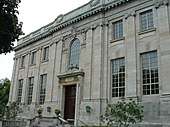 |
Shepley, Rutan and Coolidge | 1910 | 20 Prospect St. | The second library built by Brown University (the first being Robinson Hall, now home to the Economics Department), the John Hay Library served as the main library of the University until the completion of the John D. Rockefeller, Jr. Library. The library, named for John Hay (class of 1858), now houses the University's special collections and the University Archives. | [75][76] |
| Library Collections Annex | 1969 | 10 Park Ln. | Opened in 2006, the Library Collections Annex is located 4 miles (6.4 km) from Brown University's main campus. The Annex is a storage facility with a capacity of approximately 1.7 million volumes. | [44][77] | ||
| Orwig Music Center |  |
Carrère and Hastings (remodel) | 1850 (1988 addition) | 1 Young Orchard Ave. | Named for Benton B. Orwig (class of 1920), the Orwig Music Center is home to the Virginia Baldwin Orwig Music Library, which houses the general music collection, including music books, scores, periodicals, sound recordings, videotapes and microforms. | [78] |
| Sciences Library | 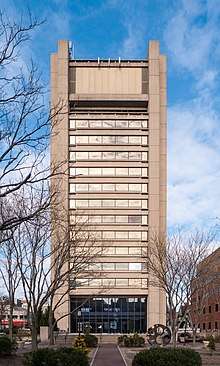 |
Warner, Burns, Toan and Lunde | 1969–1971 | 201 Thayer St | A 14-story building completed in the Brutalist architectural style, the Sciences Library houses the University's collection of science volumes as well as the Friedman Study Center. | [44][79] |
Residential Buildings
Residence Halls
East Campus
The East Campus was originally the main campus location of Brown's former neighbor Bryant College. Brown purchased Bryant's campus in 1969 for $5.0 million when the latter school moved to a new campus in Smithfield, Rhode Island. This added 10 acres (40,000 m2) of land adjacent to Brown's existing campus. In 1971, the area formerly occupied by Bryant was officially designated as East Campus.[80]
| Building | Image | Architect | Built | Capacity | Location | Notes | Reference |
|---|---|---|---|---|---|---|---|
| Barbour Hall |  |
1904 | 37 | 100 Charlesfield St. | [44] | ||
| Barbour Hall Apartments | 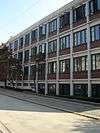 |
LLB | 1968 | ||||
| Grad Center A |  |
Shepley, Bulfinch, Richardson & Abbott | 1968 | 40 Charlesfield St. | [59] | ||
| Grad Center B |  |
Shepley, Bulfinch, Richardson & Abbott | 1968 | 44 Charlesfield St. | [59] | ||
| Grad Center C |  |
Shepley, Bulfinch, Richardson & Abbott | 1968 | 82 Thayer St. | [59] | ||
| Grad Center D |  |
Shepley, Bulfinch, Richardson & Abbott | 1968 | 90 Thayer St. | [59] | ||
| King House |  |
Stone, Carpenter & Willson | 1895 | 154 Hope St. | Originally the administration building for Bryant College and named Taft House for its first owner Robert W. Taft, King House was renamed in 1974 in honor of Lida Shaw King, former dean of Pembroke College. Currently, the building serves as a residence hall and home to one of the University's program houses, St. Anthony Hall. | [44][80] | |
| Perkins Hall |  |
Kent, Cruise & Aldrich | 1960 | 154 Power St. | Opened as Gardner Hall for Bryant College, the residence hall was later renamed Perkins Hall in 1974 in honor of Judge Fred B. Perkins (class of 1919). Today the building is occupied entirely by sophomores. | [80] | |
| Young Orchard 2 |  |
1973 | 2 Young Orchard Ave. | [80] | |||
| Young Orchard 4 |  |
1973 | 4 Young Orchard Ave. | [80] | |||
| Young Orchard 10 |  |
1973 | 10 Young Orchard Ave. | [80] | |||
| Vartan Gregorian Quad A |  |
Davis Brody Bond | 1990–1991 | 103 Thayer St. | [81] | ||
| Vartan Gregorian Quad B |  |
Davis Brody Bond | 1990–1991 | 101 Thayer St. | [81] |
Keeney Quadrangle
Keeney Quadrangle (originally named West Quadrangle) opened in 1957 as, in the words of President Barnaby Keeney, a place "to provide a dignified and happy home for the independents." The quadrangle was dedicated to Keeney in 1982.[82]
Containing 6 houses, the quadrangle houses approximately 585 students.[82]
| Building | Image | Architect | Built | Capacity | Location | Notes | Ref |
|---|---|---|---|---|---|---|---|
| Archibald House | .jpg) |
Thomas Mott Shaw | 1955–1957 | 17 Benevolent St. | Named for Raymond Clare Archibald, professor of mathematics from 1909 to 1943, Archibald House is primarily a freshman hall, containing mostly double occupancy rooms. Single occupancy rooms are assigned to upperclassmen. | [82][83] | |
| Bronson House | .jpg) |
Thomas Mott Shaw | 1955–1957 | 17 Benevolent St. | Named for Walter Cochrane Bronson (class of 1887), professor of English from 1892 to 1927, Bronson House is primarily a freshman hall, containing mostly double occupancy rooms. Single occupancy rooms are assigned to upperclassmen. | [82][84] | |
| Everett House | .jpg) |
Thomas Mott Shaw | 1955–1957 | 13 Benevolent St. | Named for Walter Goodnow Everett (class of 1885), professor of Latin, philosophy, and natural theology from 1890 to 1930, Everett House is primarily a freshman hall, containing mostly double occupancy rooms. Single occupancy rooms are assigned to upperclassmen. | [82][85] | |
| Jameson House | .jpg) |
Thomas Mott Shaw | 1955–1957 | 11 Benevolent St. | Named for John Franklin Jameson, professor of history from 1888 to 1901, Jameson House is primarily a freshman hall, containing mostly double occupancy rooms. Single occupancy rooms are assigned to upperclassmen. | [82][86] | |
| Mead House | .jpg) |
Thomas Mott Shaw | 1955–1957 | 11 Benevolent St. | Named for Albert Davis Mead, professor biology from 1895 to 1930 and vice-president of the University from 1925 to 1936, Mead House is primarily a freshman hall, containing mostly double occupancy rooms. Single occupancy rooms are assigned to upperclassmen. | [82][87] | |
| Poland House | .jpg) |
Thomas Mott Shaw | 1955–1957 | 13 Benevolent St. | Named for William Carey Poland (class of 1868), professor of classics from 1870 to 1892 and professor of art history from 1892 to 1950, Poland House is primarily a freshman hall, containing mostly double occupancy rooms. Single occupancy rooms are assigned to upperclassmen. | [82][88] |
Main Campus
| Building | Image | Architect | Built | Capacity | Location | Notes | Ref |
|---|---|---|---|---|---|---|---|
| Caswell Hall |  |
Hoppin and Ely | 1903 | 90 | 168 Thayer St. | [89] | |
| Hegeman Hall |  |
Day & Klauder | 1926 | 128 George St. | [90][91] | ||
| Hope College |  |
1822 | 78 | 71 Waterman St. | One of five Sophomore dormitories. | [92] | |
| Littlefield Hall |  |
Day & Klauder | 1925 | 78 | 102 George St. | [90][93] | |
| Minden Hall |  |
Frank W. Woods | 1912 | 121 Waterman St. | [44] | ||
| Slater Hall |  |
Stone, Carpenter & Willson | 1879 | 0
George St. |
[90][94] |
Pembroke Campus
| Building | Image | Architect | Built | Capacity | Location | Notes | Ref |
|---|---|---|---|---|---|---|---|
| Andrews Hall |  |
Thomas Mott Shaw | 1947 | 211 Bowen St. | [44] | ||
| Champlin Hall | .jpg) |
Robert C. Dean of Perry, Shaw, Hepburn and Dean | 1960 | 208 Meeting St. | One of six Freshman dormitories. | [95] | |
| Emery Hall |  |
Robert C. Dean of Perry, Shaw, Hepburn and Dean | 1963 | 200 Meeting St. | [96] | ||
| Machado House |  |
Parker, Thomas & Rice | 1912 | 87 Prospect St. | [97] | ||
| Metcalf Hall | .jpg) |
Andrews, Jacques and Rantoul | 1919 | 98 Cushing St. | The second residence hall to be built for the Women's College, Metcalf Hall was built with a donation from Stephen O. Metcalf. The hall is built directly opposite of Miller Hall, the first residence hall for the Women's College. | [90][98] | |
| Miller Hall | .jpg) |
Andrews, Jacques and Rantoul | 1910 | 50 | 118 Cushing St. | Miller Hall, named for Mr. and Mrs. Horace G. Miller who provided funds to build the hall, is a colonial style building of brick with white limestone trim and was the first residence hall built for the Women's College. | [99] |
| Morriss Hall | .jpg) |
Robert C. Dean of Perry, Shaw, Hepburn and Dean | 1960 | 206 Meeting St. | [95] | ||
| New Pembroke #1 | .jpg) |
Donlyn Lyndon | 1974 | 302 Thayer St. | [100] | ||
| New Pembroke #2 | .jpg) |
Donlyn Lyndon | 1974 | 306 Thayer St. | [100] | ||
| New Pembroke #3 | .jpg) |
Donlyn Lyndon | 1974 | 308 Thayer St. | [100] | ||
| New Pembroke #4 | .jpg) |
Donlyn Lyndon | 1974 | 300 Thayer St. | [100] | ||
| North House | .jpg) |
1900 | 111 Brown St. | North House is one of the University's environmental program houses, along with West House. | [44][101] | ||
| Plantations House | 1896 | 219 Bowen St. | Also known as the George W. Harris House, Plantations House was built as a residence in the Colonial Revival style | [44] | |||
| West House | .jpg) |
1885 | 91 Brown St. | West House is one of the University's environmental program houses, along with North House. | [44] | ||
| Woolley Hall |  |
Robert C. Dean of Perry, Shaw, Hepburn and Dean | 1963 | 202 Meeting St. | [96] |
Wriston Quadrangle
Wriston Quadrangle, built from 1950 to 1952, consists of 9 residential buildings bordered by George Street, Thayer Street, Charlesfield Street, and Brown Street. Fifty-one buildings in total were razed to make space for the development. The buildings were designed to house a fraternity on each end of the building, with independents living in the rooms in between.[102]
At the time the quad was built, many (though not all) of the University's fraternities were in financial trouble and membership numbers struggled due to the limited number of civilian students on campus (much of the University's housing at the time was used for students in the Armed Forces training program). In return for University housing in Wriston Quadrangle, the fraternities were compelled to deed their privately owned houses (many in disrepair) to the University.[103]
The quad still houses the majority of the University's fraternities, sororities, and program houses.
| Building | Image | Architect | Built | Capacity | Location | Notes | Ref |
|---|---|---|---|---|---|---|---|
| Buxton House |  |
Perry, Shaw and Hepburn | 1950–1952 | 27 Brown St. | Buxton House is named for Colonel G. Edward Buxton, Jr. (class of 1902), who was Chairman of the Housing and Development Campaign for Wriston Quadrangle. The house is currently home to Buxton International House, one of Brown's program houses. | [102] | |
| Chapin House | 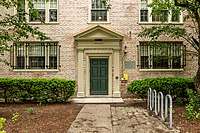 |
Perry, Shaw and Hepburn | 1950–1952 | 116 Thayer St. | Chapin House is named for Dr. Charles V. Chapin (class of 1876), professor of Physiology. Chapin was Superintendent of Health in Providence for 48 years and pioneered modern methods of treating infectious diseases in the Providence City Hospital. Chapin House is home to both the Theta Delta Chi fraternity and Harambee House, one of Brown's program houses. | [102][104] | |
| Diman House |  |
Perry, Shaw and Hepburn | 1950–1952 | 41 Charlesfield St. | Diman House is named for Jeremiah Lewis Diman (class of 1851), professor of History at the University. The building is home to both the Kappa Alpha Theta sorority and Interfaith House, one of Brown's program houses. | [102][105] | |
| Goddard House |  |
Perry, Shaw and Hepburn | 1950–1952 | 39 Charlesfield St. | Goddard House is named for William Giles Goddard (class of 1812), professor of Moral Philosophy and Metaphysics and of "Belles-Lettres" and Trustee and Fellow of the University. Goddard House is home to the Alpha Delta Phi Society and Delta Phi fraternity. | [102][106] | |
| Harkness House |  |
Perry, Shaw and Hepburn | 1950–1952 | 47 Charlesfield St. | Harkness House is named for Professor Albert Harkness (class of 1842), professor of Classics and a Fellow of the University from 1904 to 1907. Harkness House is home to both the Kappa Delta sorority and Technology House, one of Brown's program houses. | [102][107] | |
| Marcy House |  |
Perry, Shaw and Hepburn | 1950–1952 | 115 George St. | Marcy House is named for William L. Marcy (class of 1808), Comptroller of the State of New York, U.S. Senator, Governor of New York for three terms, Secretary of War, and U.S. Secretary of State. Marcy House is houses both the Beta Rho Pi (formerly known as Alpha Epsilon Pi) Fraternity and the Zeta Delta Xi Fraternity. | [102][108] | |
| Olney House |  |
Perry, Shaw and Hepburn | 1950–1952 | 29 Brown St. | Olney is named for Richard Olney (class of 1856), Attorney General to President Cleveland and U.S. Secretary of State. Olney House is home to the Sigma Chi fraternity, the Delta Tau fraternity, and Cooking House, one of Brown's program houses. | [102][109] | |
| Sears House |  |
Perry, Shaw and Hepburn | 1950–1952 | 113 George St. | Sears House, named for Barnas Sears (class of 1825), president of the University from 1855 to 1867. The building is home to both the Alpha Chi Omega sorority and Phi Kappa Psi fraternity | [102][110] | |
| Wayland House |  |
Perry, Shaw and Hepburn | 1950–1952 | 31 Brown St. | Wayland House is named for Francis Wayland, president from 1827 to 1855. The first floor of Wayland House is occupied by the Office of Residential Life and the Office of Auxiliary Housing. The doubles on the upper floors are used to house freshman; the singles and fourth floor suites are occupied by upperclassmen. The building is also the home of the Jabberwocks of Brown University, the school's oldest male a cappella group, who maintain their practice room and headquarters in the basement of North Wayland. | [102][111] |
Rental Properties
Brown owns many properties that it leases to others for various purposes.
| Building | Image | Architect | Built | Notes | Ref |
|---|---|---|---|---|---|
| 127 Angell Street | 1853 | Also known as the Leonard M. Blodgett House | [44] | ||
| 129 Angell Street | 1849 | Also known as the Edward J. Cushing House | [44] | ||
| 22 Benevolent Street |  |
1816 | Also known as the Sylvanus and Samuel Tingley, Jr. House | [44] | |
| 70-72 Benevolent Street |  |
1880 | [44] | ||
| 74-80 Benevolent Street |  |
1883 | The home features locking mechanisms and security measures developed by the U.S. Secret Service from when Prince Faisal bin Al Hussein of Jordan (Brown class of 1985) lived here. | [44] | |
| 84 Benevolent Street | 1865 | [44] | |||
| 86 Benevolent Street | 1865 | [44] | |||
| 95 Benevolent Street | 1885 | [44] | |||
| 97 Benevolent Street | 1854 | Also known as the Robert Watson House | [44][5] | ||
| 99 Benevolent Street | 1860 | [44] | |||
| 247 Bowen Street | 1895 | Also known as the Francis A . Cranston House | [44][5] | ||
| 251 Bowen Street | 1900 | [44] | |||
| 245-247 Brook Street | 1900 | [44] | |||
| 277 Brook Street | 1866 | [44] | |||
| 281-283 Brook Street | 1880 | [44] | |||
| 93 Brown Street | 1885 | [44] | |||
| 95 Brown Street |  |
1885 | [44] | ||
| 131-133 Brown Street | 1850 | Also known as the Albert Dailey House | [44][5] | ||
| 38 Charlesfield Street | .jpg) |
1845 | Originally built by Robert Purkis and deeded to Brown University in 1946, the home was originally located across the street and moved to its current location in 1950, coinciding with the construction of Wriston Quadrangle. Currently, the house is occupied by a member of the University's Faculty Fellow program. | [112] | |
| 59 Charlesfield Street |  |
James C. Bucklin | 1877 | Also known as the William D. Fuller House, 59 Charlesfield Street is part of the Watson Institute | [41][44] |
| 70-72 Charlesfield Street | .jpg) |
1915 | [44] | ||
| 71-73 Charlesfield Street | .jpg) |
1872 | Acquired by Brown in 1969 as part of the purchase of the former site of Bryant College, 71-73 Charlesfield Street was renovated in 2006–2007 to contain 18 studio apartments and two one-bedroom apartments for use by first year graduate students. Originally known as the George Fuller Double House, the building is now known as Milhous and used by the Brown Association for Cooperative Housing. | [113][114][115] | |
| 108-110 Charlesfield Street | 1910 | [44] | |||
| 84-86 Cushing Street | 1895 | [44] | |||
| 154 Cushing Street | 1895 | [44] | |||
| 134 Hope Street |  |
1910 | [44] | ||
| 20 Olive Street | 1849 | 20 Olive Street was built in with funds provided by Anna A. Jenkins for the Association for the Benefit of Colored Orphans, a Quaker orphanage founded in 1839. The building was sold in 1952. | [44][116] | ||
| 307 Thayer Street | 1865 | [44] | |||
| 86 Waterman Street | 1880 | [44] |
Additional Facilities
| Building | Image | Architect | Built | Location | Notes | Ref |
|---|---|---|---|---|---|---|
| Andrews House | .jpg) |
Ogden Codman | 1901 | 13 Brown St. | Originally built for James Coats and later serving as the Governor's Mansion, the University purchased the building in 1922 and named it in honor of President E. Benjamin Andrews. Andrews House is now home to Brown's infirmary and Health Services. | [117] |
| Carrie Tower | 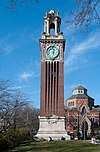 |
Guy Lowell | 1904 | 69 Waterman | Located on the corner of Prospect and Waterman Streets, Carrie Tower is a 95-foot (29 m) tall monument named in honor of Caroline Mathilde Brown, granddaughter of Nicholas Brown. Carved into the granite foundation is the inscription "Love is Strong as Death." | [118] |
| Mencoff Hall | 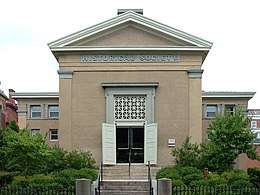 |
Tallman & Bucklin; Stone, Carpenter & Willson (1891 addition) | 1844 | 68 Waterman St. | Mencoff Hall was formerly named the Cabinet Building as it was built to house the cabinet of the Rhode Island Historical Society. The building was acquired by the University in 1942 and currently houses the Population Studies and Training Center. | [119] |
| Center for the Study of Slavery and Justice | Alpheus C. Morse (renovated) | 1810 | 94 Waterman St. | Brown's Center for the Study of Slavery and Justice is housed in a Federal style residence formerly known as the James W.C. Ely House | ||
| Central Heat Plant | 1969 | 235 Lloyd Ave. | The Central Heat Plant provides heat for over 90 buildings on the University's campus. Undergoing renovations from 2005 to 2008, President Ruth Simmons announced that the plant would reduce greenhouse gas emissions from fossil fuels by 30% by fiscal year 2008. | [44][120][121] | ||
| 75-77 Charlesfield Street | .jpg) |
1967 | 75-77 Charlesfield Street is the headquarters for the Department of Public Safety. | [122] | ||
| 37 Cooke Street | Stone, Carpenter & Sheldon | 1909 | Also known as the Charles H. Merriman, 37 Cooke Street is the home of the University's Provost. | [123] | ||
| Faculty Club |  |
Alfred E. Stone | 1865 | 1 Bannister St. | Originally the home of Zachariah Allen a prominent citizen of Providence and 1813 Brown graduate. | |
| Faunce House |  |
McKim Mead and White,
Howe and Church |
1904, 1930 | 75 Waterman St. | Originally named "Rockefeller Hall". Designed by McKim, Mead & White. Currently houses the "Stephen Robert '62 Campus Center". | |
| Fox Point Daycare Center | 1961 | 150 Hope St. | Originally built as Kilcup Hall, Brown purchased the building in 1969 when Bryant College moved from Providence, Rhode Island to Smithfield, Rhode Island. In 1979 the center incorporated as a private nonprofit organization. The University allows the center to use the building rent-free. | [80][124] | ||
| 50 John Street | 1910 | 50 John Street is used as a storage facility for the Department of Environmental Health and Safety. In 2003, the space was renovated to accommodate the Department of Theatre, Speech and Dance and the Theatre Consortium. The facility is equipped as a professional shop and supports set design and construction for the Department's mainstage productions. | [125][126] | |||
| Gardner House | .jpg) |
1806 | 106 George St. | Originally built for Joseph Haile, Gardner house bears the name of George Warren Gardner, M.D. (class of 1894) and his wife, Jessie Barker Gardner (class of 1896), the couple who restored the house back to its original condition. Gardner House serves as the guest house for the President of Brown University, lodging distinguished guests and visiting dignitaries. | [127][128] | |
| Ladd Observatory | 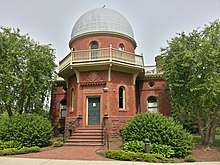 |
Stone, Carpenter, and Willson | 1891 | 210 Doyle Ave. | Built on "Tin-top Hill," about a mile from the University's main campus, Ladd Observatory was built through the munificence of Governor Herbert W. Ladd on land donated by Frank W. and Knight D. Cheney. The observatory contains a refractor telescope with lens designed by Professor C. S. Hastings of Yale University. The observatory has been listed with the National Register of Historic Places since 2000. | [53][129][130] |
| 295 Lloyd Avenue | 2003 | The 50,000-square-foot (4,600 m2) building at 295 Lloyd Avenue houses the staff of the Department of Facilities Management. | [131] | |||
| Nightingale-Brown House | 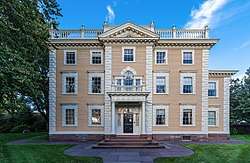 |
Caleb Ormsbee | 1791 (1862 Library wing addition; 1880 addition) | 357 Benefit St. | Built for Colonel Joseph Nightingale, the Nightingale-Brown House was purchased by Nicholas Brown in 1814 and housed members of the Brown family until 1985. The house is now preserved as the John Nicholas Brown Center for Public Humanities and Cultural Heritage. The house was designated a National Historic Landmark in 1989. | [132][133] |
| Pembroke Field House | 1938 | 171 Cushing St | Originally the barn on the estate of Charles T. Aldrich (class of 1877) and Henry L. Aldrich (class of 1876), Pembroke Field House opened in 1938 after renovation financed by various University classes. Currently, the field house is used as a function hall. | [134] | ||
| Power Street Garage | 1988 | 101 Power St. | The Power Street Garage is a two-story parking facility with approximately 400 total parking spaces. | [44][135] | ||
| 89 Power Street | 1842 | [44] | ||||
| President's House |  |
William T. Aldrich | 1922 | 55 Power St. | The current President's House, originally built for Rush Sturges and acquired by the University in 1947, is the fourth such home for the University president (the first three have been demolished). | [136] |
| Sharpe Refectory |  |
Perry, Shaw and Hepburn | 1951 | 144 Thayer St. | Nicknamed "the Ratty" by students, Sharpe Refectory is Brown's largest dining hall. It is located on Wriston Quad near the center of campus. Food service is all-you-care-to-eat with several hot and cold food stations available at each meal. Several times each semester, the Ratty features theme meals complete with decoration. Payment can be made via meal plan credits or Flex points, cash, or Brown card cash equivalents (declining balance). | [44][137] |
| Taft Avenue Daycare Center | 1982 | [44] | ||||
| 285 Tockwotten Street | 1895 | [44] |
Commercial Properties
Brown University owns several properties that are not yet used to support the institution's mission. These properties are leased to businesses until such time that the University expands into the buildings.
| Building | Image | Location | Built | Notes | Ref |
|---|---|---|---|---|---|
| 83-85 Benevolent Street | College Hill | 1857 | 83-85 Benevolent Street is a restaurant/bar building that has had a variety of tenants. | [44][138] | |
| 248-254 Brook Street | College Hill | 1900 | 248-254 Brook Street is a strip shopping center built on the site of a former gas station. Its stores include a variety of services and food vendors. In October 2003, the University announced that the Providence Police District 9 Substation would be located, rent free, in the mall. | [44][139] | |
| 1 Davol Square | Jewelry District | [140] | |||
| 10 Davol Square | Jewelry District | [140] | |||
| 339 Eddy Street | Jewelry District | [140] | |||
| 349 Eddy Street | Jewelry District | [140] | |||
| 196 Richmond Street | Jewelry District | [140] | |||
| 233 Richmond Street | Jewelry District | [140] |
Athletic Facilities
| Building | Image | Architect | Built | Location | Notes | Ref |
|---|---|---|---|---|---|---|
| Brown Stadium |  |
Gavin Hadden, Paul Cret | 1925 | Opened as Brown University Field, Brown Stadium is home to the University's football and outdoor track teams. The stadium is located approximately 1-mile (1.6 km) from main campus and has a capacity of approximately 20,000. | [141] | |
| Marston Boat House | 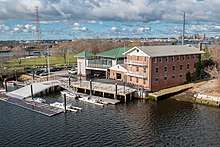 |
1966 (acquired) | The Marston Boat House is located close to India Point Park in Providence along the Seekonk River and is home to Brown's crew team. | [142] | ||
| Meehan Auditorium |  |
Perry, Shaw, Hepburn & Dean | 1961 | Named in honor of George V. Meehan, Meehan Auditorium holds an ice rink for intercollegiate hockey games and also serves as a venue for large indoor events. The auditorium holds 2100, increasing to 5000 when temporary seating covers the ice surface. | [44][143] | |
| Olney-Margolies Athletic Center |  |
Daniel F. Tully | 1981 | Named for Joseph Olney and Moe Price Margolies (both class of 1936), the Olney-Margolies Athletic Center contains space for basketball, tennis, and volleyball courts, a six-lane 200-meter track, batting and golf cages, and long jump, high jump, and pole vault pits. There is also a 1.8-acre (7,300 m2) playing field located on the roof. | [144] | |
| Pizzitola Sports Center |  |
Eggers Group | 1987–1988 | 235 Hope St. | The Pizzitola Sports Center, named for Paul Bailey Pizzitola (class of 1981), holds the University's courts for basketball, volleyball, and squash as well as facilities for wrestling and gymnastics and four tennis courts. The main competition court seats approximately 2,800. | [145] |
| Ted Turner Sailing Center | 2018 | The Ted Turner Sailing Center at the Edgewood Yacht Club is used by Brown's sailing team. | ||||
| Nelson Fitness Center and Katherine Moran Coleman Aquatics Center |  |
Robert A.M. Stern Architects | 2012 | 225 Hope St. | [146] | |
| Center for Lacrosse and Soccer | 2020 (expected) | Stevenson Field |
Vacant Properties
| Building | Image | Architect | Built | Notes | Ref |
|---|---|---|---|---|---|
| 66-68 Benevolent Street |  |
1880 | [44] | ||
| 66-68 Charlesfield Street | .jpg) |
1915 | [44] |
References
- "Brown University Historic District Map". Brown University. Retrieved 2007-12-12.
- Stacey, Kevin (23 September 2015). "Applied Mathematics building: Open for occupancy". Providence, RI: Brown University. Retrieved 3 June 2018.
- Mitchell, Martha (1993). "Arnold Laboratory". Encyclopedia Brunoniana. Providence, RI: Brown University Library. ASIN B0006P9F3C. Retrieved 2008-03-23.
- Mitchell, Martha (1993). "Barus and Holley Building". Encyclopedia Brunoniana. Providence, RI: Brown University Library. ASIN B0006P9F3C. Retrieved 2007-12-06.
- "National Register of Historic Places Inventory -- Nomination Form, College Hill" (PDF). 1989.
- "Samuel B. Wheaton House—Built Works Registry". www.builtworksregistry.org. Retrieved 2020-05-13.
- Mitchell, Martha (1993). "Kassar House". Encyclopedia Brunoniana. Providence, RI: Brown University Library. ASIN B0006P9F3C. Retrieved 2008-03-23.
- Stacey, Kevin (20 October 2017). "Let the move-in begin: Engineering Research Center opens its doors". Brown University. Retrieved 4 June 2018.
- "Brown University, Engineering Research Center". BuroHappold Engineering. Retrieved 4 June 2018.
- Hyde-Keller, O'rya (5 September 2018). "Friedman Hall opens its doors, culminating renewal of an iconic Brown building". News From Brown. Retrieved 6 October 2018.
- Mitchell, Martha (1993). Encyclopedia Brunoniana. Brown University Library. Retrieved 7 October 2018.
- Mitchell, Martha (1993). "Computing Laboratory". Encyclopedia Brunoniana. Providence, RI: Brown University Library. ASIN B0006P9F3C. Retrieved 2011-02-16.
- "The Henry and Elizabeth Pearce Estate". Brown University Department of Applied Mathematics. Retrieved 25 July 2014.
Angell and Swift held special admiration for the architectural genius of Henry Hobson Richardson, whose worldly and Victorian design founded the romanesque revival style.
- "Whipple-Slater & William J. King Houses // Guide to Providence Architecture". guide.ppsri.org. Retrieved 2020-05-09.
- "BROWN UNIVERSITY - Providence, Rhode Island: Charles Giancarlo Engineering Laboratories Providence, Rhode Island". Archived from the original on 2008-01-23. Retrieved 2007-12-12.
- Knecht, Barbara. "Accessibility Regulations and a Universal Design Philosophy inspire the Design Process". Retrieved 2007-12-12.
- Baum, Deborah (25 January 2011). "The Granoff Center for the Creative Arts opens at Brown". Brown University. Retrieved 3 June 2018.
- Mitchell, Martha (1993). "Horace Mann House". Encyclopedia Brunoniana. Providence, RI: Brown University Library. ASIN B0006P9F3C. Retrieved 2015-07-27.
- Jordy, William H (1982). Buildings on Paper: Rhode Island Architectural Drawings, 1825-1945. Providence, RI: List Art Center, Brown University. pp. 181–3. ASIN B001U6QNN6.
- Marcelo, Philip (2006-10-26). "Federal money earmarked to purchase land in Foster". The Providence Journal. Retrieved 2007-12-18.
- Bethea, Charles (2003-11-13). "Go Tell it on the Hill: The little rock that couldn't (be climbed)". The College Hill Independent. Archived from the original on 2006-03-21. Retrieved 2007-12-18.
- Mitchell, Martha (1993). "List Art Building". Encyclopedia Brunoniana. Providence, RI: Brown University Library. ASIN B0006P9F3C. Retrieved 2011-02-16.
- "Lyndsey Barnes: 48 College Street, The Classics Department". www.brown.edu. Retrieved 2020-05-09.
- Turner, Scott (September 28, 1998). "W. Duncan MacMillan Hall: Science instruction for the 21st century". The Brown University News Bureau. Retrieved 29 December 2017.
- Turner, Scott (September 28, 1998). "Dedication of MacMillan Hall: Brown to open new science building for public tours Saturday, Oct. 10". The Brown University News Bureau. Retrieved 29 December 2017.
- Hyde-Keller, Orya (18 December 2017). "Nelson Center for Entrepreneurship plans for dedicated new home on Thayer Street". Brown University. Retrieved 25 October 2019.
- Zhang, Auria (20 February 2019). "Nelson Entrepreneurship Center to relocate on Thayer". Brown Daily Herald. Retrieved 25 October 2019.
- Mitchell, Martha (1993). "Nicholson House". Encyclopedia Brunoniana. Providence, RI: Brown University Library. ASIN B0006P9F3C. Retrieved 2007-12-17.
- "American Studies". Contact Us. Brown University. Retrieved 7 April 2019.
American Studies Department Nicholson House 71 George Street
- Nickel, Mark (September 10, 2014). "TWC to re-brand, plans for growth". Brown University. News from Brown. Retrieved 24 April 2017.
- Baum, Deborah (July 24, 2007). "On the Move: Historic House Relocates to Make Way for The Walk".
- Mitchell, Martha (1993). "Prince Engineering Laboratory". Encyclopedia Brunoniana. Providence, RI: Brown University Library. ASIN B0006P9F3C. Retrieved 2007-12-06.
- Mitchell, Martha (1993). "Rhode Island Hall". Encyclopedia Brunoniana. Providence, RI: Brown University Library. ASIN B0006P9F3C. Retrieved 2007-12-06.
- "The Transformation of Rhode Island Hall". Joukowsky Institute for Archaeology. Brown University. Retrieved 4 June 2018.
- https://brown.edu/Facilities/Facilities_Management/maps/#building/RICHMND222
- "Sharpe House Relocation". Brown University Facilities Management.
- "Brown Dedicates Sidney E. Frank Hall for Life Sciences" (Press release). Brown University Public Affairs and University Relations. 6 October 2006. Retrieved 3 June 2018.
- Brenner, Diana (8 January 2016). "Intelligent Design – Smith-Buonanno Hall". Brenner Design. Retrieved 24 December 2018.
- "Smith-Buonanno Hall, Brown University". KITE Architects. KITE Architects. Retrieved 24 December 2018.
- "Brown To Purchase 121 South Main, Former Old Stone Bank Building" (Press release). Brown University News Bureau. 1999-03-09. Retrieved 2005-09-12.
- Kiley, Gillian (12 December 2018). "Newly expanded Watson Institute opens the doors to Stephen Robert Hall". Brown University. Retrieved 23 March 2019.
- "85 Waterman Street". Brown University. Building Brown: a guide to construction projects. Retrieved 24 April 2017.
- "Benevolent Street 005" (PDF). Brown University. Retrieved 2007-12-12.
- "Brown University Institutional Master Plan" (PDF). Brown University. 2006-08-10. Retrieved 2007-12-06.
- "Benevolent Street 026" (PDF). Brown University. Retrieved 2007-12-12.
- Mitchell, Martha (1993). "Sarah Doyle Women's Center". Encyclopedia Brunoniana. Providence, RI: Brown University Library. ASIN B0006P9F3C. Retrieved 2007-12-06.
- "Benoni Cooke House, 110 South Main Street, Providence, Providence County, RI". Historic American Buildings Survey/Historic American Engineering Record/Historic American Landscapes Survey. Library of Congress. Retrieved 2007-12-12.
- "Benoni Cooke House" (PDF). Brown University. Retrieved 2007-12-12.
- "Brown buys Old Stone Bank building to house the Haffenreffer Museum" (Press release). Brown University News Bureau. 1995-08-24. Retrieved 2007-12-12.
- "Brown Office Building" (PDF). Brown University. Retrieved 2007-12-18.
- Mitchell, Martha (1993). "Brown Office Building". Encyclopedia Brunoniana. Providence, RI: Brown University Library. ASIN B0006P9F3C. Retrieved 2007-12-06.
- Mitchell, Martha (1993). "Corliss-Brackett House". Encyclopedia Brunoniana. Providence, RI: Brown University Library. ASIN B0006P9F3C. Retrieved 2007-12-06.
- "National Register Information System". National Register of Historic Places. National Park Service. July 9, 2010.
- "At Brown: CIS begins move to Davol Square". George Street Journal. 2004-01-30. Archived from the original on 2006-09-19. Retrieved 2007-12-13.
- "110 Elm Street". Art in Ruins. Retrieved 2007-12-12.
- "Most Endangered Properties List". Providence Preservation Society. Retrieved 2007-12-12.
- "Financial Aid Office" (PDF). Brown University. Retrieved 2007-12-18.
- Mitchell, Martha (1993). "Swearer Center for Public Service". Encyclopedia Brunoniana. Providence, RI: Brown University Library. ASIN B0006P9F3C. Retrieved 2007-12-17.
- Mitchell, Martha (1993). "Graduate Center". Encyclopedia Brunoniana. Providence, RI: Brown University Library. ASIN B0006P9F3C. Retrieved 2007-12-06.
- "Annenberg Institute". Retrieved 2007-12-12.
- "Thomas F. Hoppin House, 383 Benefit Street, Providence, Providence County, RI". Historic American Buildings Survey/Historic American Engineering Record/Historic American Landscapes Survey. Library of Congress. Retrieved 2007-12-12.
- Mitchell, Martha (1993). "Maddock Alumni Center". Encyclopedia Brunoniana. Providence, RI: Brown University Library. ASIN B0006P9F3C. Retrieved 2007-12-17.
- "Inside the Maddock Alumni Center at Brown University" (PDF). Brown University. Retrieved 2007-12-20.
- "J. Walter Wilson Laboratory". Encyclopedia Brunoniana. Retrieved 9 May 2020.
- "J. Walter Wilson Student Resource Building at Brown University". LLB Architects. Retrieved 9 May 2020.
- Hyde-Keller, O'rya (22 September 2018). "Newly renamed Page-Robinson Hall will honor Brown's first black graduates". Brown University. Retrieved 2 February 2019.
- Nesi, Ted (29 November 2017). "Old power station transformed as ribbon cut on $220M South Street Landing project". WPRI Eyewitness News. Retrieved 3 May 2018.
- Mitchell, Martha (1993). "University Hall". Encyclopedia Brunoniana. Providence, RI: Brown University Library. ASIN B0006P9F3C. Retrieved 2007-12-06.
- "University Hall, Brown University". National Historic Landmarks Program. National Park Service. Archived from the original on 2011-06-06. Retrieved 2007-12-12.
- "Center for the Study of Human Development". Brown University. Archived from the original on 2008-05-16. Retrieved 2007-12-20.
- "About the Libraries: Annmary Brown Memorial". Brown University. Retrieved 2007-12-06.
- Mitchell, Martha (1993). "Annmary Brown Memorial". Encyclopedia Brunoniana. Providence, RI: Brown University Library. ASIN B0006P9F3C. Retrieved 2007-12-06.
- Mitchell, Martha (1993). "John Carter Brown Library". Encyclopedia Brunoniana. Providence, RI: Brown University Library. ASIN B0006P9F3C. Retrieved 2007-12-06.
- Mitchell, Martha (1993). "Rockefeller Library". Encyclopedia Brunoniana. Providence, RI: Brown University Library. ASIN B0006P9F3C. Retrieved 2007-12-06.
- "John Hay Library: General Information". Brown University. Retrieved 2007-12-06.
- Mitchell, Martha (1993). "John Hay Library". Encyclopedia Brunoniana. Providence, RI: Brown University Library. ASIN B0006P9F3C. Retrieved 2007-12-06.
- "libraries: LIBRARY COLLECTIONS ANNEX". Brown University. Retrieved 2007-12-06.
- Mitchell, Martha (1993). "Orwig Music Center". Encyclopedia Brunoniana. Providence, RI: Brown University Library. ASIN B0006P9F3C. Retrieved 2007-12-06.
- Mitchell, Martha (1993). "Sciences Library". Encyclopedia Brunoniana. Providence, RI: Brown University Library. ASIN B0006P9F3C. Retrieved 2007-12-06.
- Mitchell, Martha (1993). "Bryant College". Encyclopedia Brunoniana. Providence, RI: Brown University Library. ASIN B0006P9F3C. Retrieved 2007-12-06.
- "Dedication of Gregorian Quadrangle scheduled for Monday, April 12" (Press release). Brown University News Bureau. 1999-03-09. Retrieved 2007-12-06.
- Mitchell, Martha (1993). "Keeney Quadrangle". Encyclopedia Brunoniana. Providence, RI: Brown University Library. ASIN B0006P9F3C. Retrieved 2007-12-06.
- Mitchell, Martha (1993). "Archibald, Raymond C.". Encyclopedia Brunoniana. Providence, RI: Brown University Library. ASIN B0006P9F3C. Retrieved 2007-12-17.
- Mitchell, Martha (1993). "Bronson, Walter C.". Encyclopedia Brunoniana. Providence, RI: Brown University Library. ASIN B0006P9F3C. Retrieved 2007-12-17.
- Mitchell, Martha (1993). "Everett, Walter G.". Encyclopedia Brunoniana. Providence, RI: Brown University Library. ASIN B0006P9F3C. Retrieved 2007-12-17.
- Mitchell, Martha (1993). "Jameson, John Franklin". Encyclopedia Brunoniana. Providence, RI: Brown University Library. ASIN B0006P9F3C. Retrieved 2007-12-17.
- Mitchell, Martha (1993). "Mead, Albert D.". Encyclopedia Brunoniana. Providence, RI: Brown University Library. ASIN B0006P9F3C. Retrieved 2007-12-17.
- Mitchell, Martha (1993). "Poland, William Carey". Encyclopedia Brunoniana. Providence, RI: Brown University Library. ASIN B0006P9F3C. Retrieved 2007-12-17.
- Mitchell, Martha (1993). "Caswell Hall". Encyclopedia Brunoniana. Providence, RI: Brown University Library. ASIN B0006P9F3C. Retrieved 2007-12-06.
- R.M.Kliment & Frances Halsband Architects (February 2006). "Campus Heritage at Brown University" (PDF). Brown University. Retrieved 2007-12-06.
- Mitchell, Martha (1993). "Hegeman Hall". Encyclopedia Brunoniana. Providence, RI: Brown University Library. ASIN B0006P9F3C. Retrieved 2007-12-06.
- Mitchell, Martha (1993). "Hope College". Encyclopedia Brunoniana. Providence, RI: Brown University Library. ASIN B0006P9F3C. Retrieved 2007-12-06.
- Mitchell, Martha (1993). "Littlefield Hall". Encyclopedia Brunoniana. Providence, RI: Brown University Library. ASIN B0006P9F3C. Retrieved 2007-12-06.
- Mitchell, Martha (1993). "Slater Hall". Encyclopedia Brunoniana. Providence, RI: Brown University Library. ASIN B0006P9F3C. Retrieved 2007-12-06.
- Mitchell, Martha (1993). "Champlin and Morriss Halls". Encyclopedia Brunoniana. Providence, RI: Brown University Library. ASIN B0006P9F3C. Retrieved 2007-12-06.
- Mitchell, Martha (1993). "Emery and Woolley Halls". Encyclopedia Brunoniana. Providence, RI: Brown University Library. ASIN B0006P9F3C. Retrieved 2007-12-06.
- Mitchell, Martha (1993). "Machado House". Encyclopedia Brunoniana. Providence, RI: Brown University Library. ASIN B0006P9F3C. Retrieved 2007-12-06.
- Mitchell, Martha (1993). "Metcalf Hall". Encyclopedia Brunoniana. Providence, RI: Brown University Library. ASIN B0006P9F3C. Retrieved 2007-12-06.
- Mitchell, Martha (1993). "Miller Hall". Encyclopedia Brunoniana. Providence, RI: Brown University Library. ASIN B0006P9F3C. Retrieved 2007-12-06.
- Mitchell, Martha (1993). "New Pembroke". Encyclopedia Brunoniana. Providence, RI: Brown University Library. ASIN B0006P9F3C. Retrieved 2007-12-06.
- Chaiken, Jackson (February 26, 2016). "North House granted one year to fill empty rooms". Brown Daily Herald. Retrieved 24 April 2017.
- Mitchell, Martha (1993). "Wriston Quadrangle". Encyclopedia Brunoniana. Providence, RI: Brown University Library. ASIN B0006P9F3C. Retrieved 2007-12-06.
- Whitney, Vincent Heath (January 1955). "Fraternities at Brown University (in Segregation and Integration in College Fraternities)". Social Problems. 2 (3): 153–159. doi:10.1525/sp.1955.2.3.03a00040. JSTOR 799060.
- Mitchell, Martha (1993). "Chapin, Charles V.". Encyclopedia Brunoniana. Providence, RI: Brown University Library. ASIN B0006P9F3C. Retrieved 2007-12-06.
- Mitchell, Martha (1993). "Diman, Jeremiah Lewis". Encyclopedia Brunoniana. Providence, RI: Brown University Library. ASIN B0006P9F3C. Retrieved 2007-12-06.
- Mitchell, Martha (1993). "Goddard, William Giles". Encyclopedia Brunoniana. Providence, RI: Brown University Library. ASIN B0006P9F3C. Retrieved 2007-12-06.
- Mitchell, Martha (1993). "Harkness, Albert 1842". Encyclopedia Brunoniana. Providence, RI: Brown University Library. ASIN B0006P9F3C. Retrieved 2007-12-06.
- Mitchell, Martha (1993). "Marcy, William L.". Encyclopedia Brunoniana. Providence, RI: Brown University Library. ASIN B0006P9F3C. Retrieved 2007-12-06.
- Mitchell, Martha (1993). "Olney, Richard". Encyclopedia Brunoniana. Providence, RI: Brown University Library. ASIN B0006P9F3C. Retrieved 2007-12-06.
- Mitchell, Martha (1993). "Sears, Barnas". Encyclopedia Brunoniana. Providence, RI: Brown University Library. ASIN B0006P9F3C. Retrieved 2007-12-06.
- Mitchell, Martha (1993). "Wayland, Francis". Encyclopedia Brunoniana. Providence, RI: Brown University Library. ASIN B0006P9F3C. Retrieved 2007-12-06.
- "Records of #38 Charles Field Street" (PDF). Providence Preservation Society. Retrieved 2008-07-02.
- "Records of 71-73 Charles Field Street" (PDF). Providence Preservation Society. Retrieved 2008-07-02.
- "Milhous". Brown Association of Cooperative Housing. Archived from the original on 2008-06-01. Retrieved 2008-07-02.
- Geller, Sarah (December 8, 2006). "New grad student residence under construction". The Brown Daily Herald. Retrieved December 28, 2017.
- "Providence Shelter for Colored Children". www.rihs.org. Retrieved 2020-05-10.
- Mitchell, Martha (1993). "Andrews House". Encyclopedia Brunoniana. Providence, RI: Brown University Library. ASIN B0006P9F3C. Retrieved 2008-03-03.
- Mitchell, Martha (1993). "Carrie Tower". Encyclopedia Brunoniana. Providence, RI: Brown University Library. ASIN B0006P9F3C. Retrieved 2008-03-03.
- Mitchell, Martha (1993). "Cabinet". Encyclopedia Brunoniana. Providence, RI: Brown University Library. ASIN B0006P9F3C. Retrieved 2007-12-06.
- "Brown University Utility Systems Renewal and Upgrade Project". Brown University. Archived from the original on 2008-08-27. Retrieved 2008-03-03.
- Simmons, Ruth (2007-04-17). "An Announcement for Earth Day, 2007" (Press release). Brown University News Bureau. Retrieved 2008-03-03.
- "Department of Public Safety" (PDF). Brown University. Retrieved 2008-03-04.
- "Cooke Street 037" (PDF). Brown University. Retrieved 2008-03-04.
- "Enrollment available at Brown/Fox Point child-care center". George Street Journal. 1999-10-01. Archived from the original on 2006-09-19. Retrieved 2008-03-04.
- "John Street 050" (PDF). Brown University. Retrieved 2008-03-04.
- "Annual Report: Space Committee 2002-03" (PDF). Office of the Provost, Brown University. Retrieved 2008-03-04.
- Mitchell, Martha (1993). "Gardner House". Encyclopedia Brunoniana. Providence, RI: Brown University Library. ASIN B0006P9F3C. Retrieved 2007-12-06.
- "History of Gardner House". Brown University. Archived from the original on 2007-11-12. Retrieved 2007-12-12.
- "Stone, Alfred". National Cyclopaedia of American Biography. 11. New York, NY: James T. White & Company. 1901. p. 326. Retrieved 2007-03-04.
- Mitchell, Martha (1993). "Ladd Observatory". Encyclopedia Brunoniana. Providence, RI: Brown University Library. ASIN B0006P9F3C. Retrieved 2008-03-04.
- "Brown University and Rhode Island: Growth and Opportunity" (PDF). Brown University. p. 38. Retrieved 2008-03-04.
- "Nightingale-Brown House". National Historic Landmarks Program. National Park Service. Archived from the original on 2011-06-06. Retrieved 2008-03-04.
- "Colonel Joseph Nightingale House, 357 Benefit Street, Providence, Providence County, RI". Historic American Buildings Survey/Historic American Engineering Record/Historic American Landscapes Survey. Library of Congress. Retrieved 2008-03-04.
- Mitchell, Martha (1993). "Pembroke Field". Encyclopedia Brunoniana. Providence, RI: Brown University Library. ASIN B0006P9F3C. Retrieved 2008-03-04.
- "Brown University Institutional Master Plan Transportation Component" (PDF). Brown University. 2006-04-20. Retrieved 2008-05-26.
- Mitchell, Martha (1993). "President's House". Encyclopedia Brunoniana. Providence, RI: Brown University Library. ASIN B0006P9F3C. Retrieved 2007-12-06.
- "Sharpe Refectory (the Ratty)". Brown University. Retrieved 2010-08-16.
- "Benevolent Street 083-085" (PDF). Brown University. Retrieved 2007-12-17.
- "Brown to provide East Side substation for Providence Police" (Press release). Brown University News Bureau. 2003-10-01. Retrieved 2007-12-17.
- "Brown Agrees to Purchase Seven Buildings in Jewelry District" (Press release). Brown University Media Relations. 1999-03-09. Retrieved 2006-10-24.
- Mitchell, Martha (1993). "Stadium". Encyclopedia Brunoniana. Providence, RI: Brown University Library. ASIN B0006P9F3C. Retrieved 2007-12-06.
- "Hunter S. Marston Boathouse". Brown University. Archived from the original on 2007-11-12. Retrieved 2007-12-07.
- Mitchell, Martha (1993). "Meehan Auditorium". Encyclopedia Brunoniana. Providence, RI: Brown University Library. ASIN B0006P9F3C. Retrieved 2007-12-06.
- Mitchell, Martha (1993). "Olney-Margolies Athletic Center". Encyclopedia Brunoniana. Providence, RI: Brown University Library. ASIN B0006P9F3C. Retrieved 2007-12-06.
- Mitchell, Martha (1993). "Pizzitola Sports Center". Encyclopedia Brunoniana. Providence, RI: Brown University Library. ASIN B0006P9F3C. Retrieved 2007-12-06.
- "Fun Facts about the New Facilities!". BROWN RECREATION.
